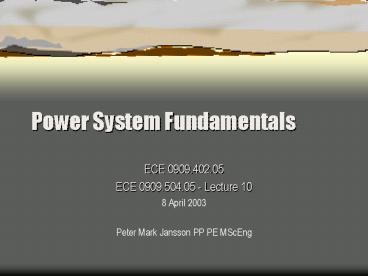Power System Fundamentals - PowerPoint PPT Presentation
1 / 14
Title:
Power System Fundamentals
Description:
... higher than the frequency of the running system (synchroscope) ... synchroscope. Measures the difference in phase angle between the phases of two systems ... – PowerPoint PPT presentation
Number of Views:266
Avg rating:3.0/5.0
Title: Power System Fundamentals
1
Power System Fundamentals
- ECE 0909.402.05
- ECE 0909.504.05 - Lecture 10
- 8 April 2003
- Peter Mark Jansson PP PE MScEng
2
Aims
- Next Weeks Tour
- Chapter 6 Parallel Operation of Synchronous
Generators - Chapter 7
- Quiz 1 (Take Home or In Class 5.45 p.m. to 7 a.m.
tomorrow)
3
Next Monday
- April 7, 2003
- 845 am
- Distribution Feeder Walk
4
Mid-Term Performance
- Very Good Performance To-Date 85.1 class
average score with 38 of marks in - Have provided a mid-term review for each student
with HW 4 - Quiz 1 today is worth 5 - Take Home/In Class
- Quiz 2 Finals Week 10
- Technical Paper 20
- windings
5
Chapter 6
- Rationale for paralleling
- Conditions for paralleling
- Procedure for paralleling
- Characteristics of a Synchronous Generator
- Operation with an Infinite Bus
- Operating with another of similar size
6
Paralleling generators
- Why?
- Higher loads
- Increased reliability under failure
- Maintenance
- More efficient operation of the fleet
7
Conditions for paralleling
- Rms line voltages must be equal
- Same phase sequence
- Phase angles must be equal
- Frequency of new generator (oncoming unit) must
be slightly higher the frequency of the running
system
8
procedure
- First verify terminal voltage of oncoming
generator equals line voltage of system - Second verify that the phase sequence of the
oncoming generator is the same as the phase
sequence of the running system (motor, bulbs) - Third adjust the frequency of the oncoming unit
to be slightly higher than the frequency of the
running system (synchroscope) - Close circuit breaker when 1-3 are satisfied and
the generator is in phase with the power system
9
synchroscope
- Measures the difference in phase angle between
the phases of two systems - Dial shows the difference between two a or b or c
phases - Faster (desirable) means clockwise from straight
up (which means in phase)
10
Characteristics of a Synchronous Generator
- When operating alone its PQ supplied will depend
entirely on the PQ demanded by the load - Governor sets the frequency and resulting Real
Power output of the synch. Generator - Field Current controls the output terminal
voltage VT and resulting Reactive Power
11
Operation with an Infinite Bus
- Infinite bus a power system so large that any
draw of reactive and real power will not affect
frequency and voltage - Result no reasonable action on the part of one
generator will cause an observable change in
system overall - Imperative that frequency of connected devices be
higher than system frequency when connecting
12
Reverse-power trip
- Most real generators are equipped with a reverse
power trip so that if they do begin to consume
power they will disconnect automatically.
13
Operating with another of similar size
- Sum of load PQ is supplied by the n generators
- Increase in governor set-point on one generator
- Increases system frequency
- Decreases power supplied by other, up on this one
- Increase in field current of one generator
- System terminal voltage is increased
- Reactive power supplied by other is decreased
14
Ch. 7 - Induction Machines
- Motors and generators whose magnetic field
current is supplied by magnetic induction
(transformer action) into the field windings of
the rotor (a DC power source is not required) - Although induction machines can be motors or
generators they have many disadvantages as
generators. Thus, they are referred to typically
as induction motors. Most popular type of AC
motor - See pages 289-291































